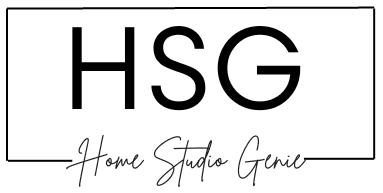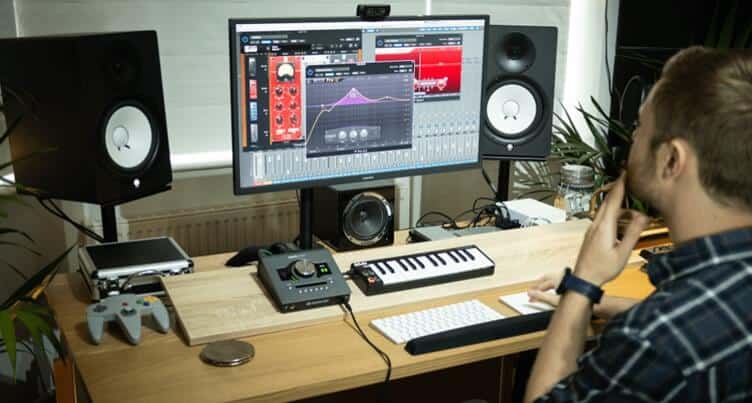As a music producer, have you considered the benefits of using an external monitor? Have you ever found yourself struggling to keep track of different elements of your project on a small screen?
In this article, we will explore the importance of using an external monitor for music production.
We’ll also check out the different types of monitors available, and the factors to consider when choosing the best one for your needs.
External Monitors for Music Production
- An external monitor is important for better visibility, resolution, color representation, and reduced eye strain during music production.
- Types of external monitors include display size, resolution, panel technology, connectivity options, and curved vs. flat monitors.
- Factors to consider when choosing an external monitor include compatibility, color accuracy, resolution, refresh rate, viewing angles, and price.
What Is An External Monitor, And Why Is It Important For Music Production?
An external monitor is an additional display that can connect to your computer, providing you with a larger screen real estate for music production.
The primary benefit of using an external monitor is that it allows you to view multiple windows at once. This makes it easier to keep track of different elements of your project.
On top of that, a larger screen provides more room to view and edit tracks, making the entire process more efficient.
Another critical factor to consider is resolution. A higher-resolution screen allows for clearer images and text, making it easier to see details and make precise edits.
This is especially important when working with graphics, as a higher-resolution screen will allow you to see the finer details of your work.
Color accuracy is also essential when producing music. An external monitor with accurate color representation can make a significant difference in the final product.
With a high-quality monitor, you’ll be able to edit your music with confidence, knowing that the colors you see on the screen will be accurately represented in the final product.
Lastly, eye strain is a common issue for music producers who spend long hours working on their projects. A larger screen can help reduce eye strain by allowing you to work at a more comfortable distance from the screen.
On top of all that, some external monitors come with blue light filters, which can further reduce eye strain and promote better sleep.
Types of External Monitors for Music Production
When choosing an external monitor for music production, several factors need to be considered. This includes display size, resolution, panel technology, connectivity options, and whether the monitor is curved or flat.
Display size is perhaps the most important factor to consider. The most common sizes for external monitors are 24-inch, 27-inch, and 32-inch.
Larger monitors are available for those who need even more screen real estate.
Resolution is another crucial factor to consider. Full HD monitors are the most common, but 4K and Ultra HD monitors are becoming increasingly popular. This is due to their ability to display more details.
Panel technology is also important when choosing an external monitor.
The most common panel technologies are IPS, TN, VA, and OLED. IPS panels are the most popular due to their wide viewing angles and accurate color representation.
Connectivity options are also a significant consideration. HDMI, DisplayPort, and USB-C are the most common connectivity options for external monitors.
Lastly, curved vs. flat monitors are a matter of personal preference.
Curved monitors can provide a more immersive viewing experience, while flat monitors are more traditional and may be more affordable.
Factors to Consider When Choosing an External Monitor for Music Production
When choosing an external monitor for music production, several factors need to be considered.
These include compatibility with your computer, color accuracy, resolution, refresh rate, viewing angles, and price.
Compatibility with your computer is perhaps the most important factor to consider. Make sure the monitor you choose is compatible with your device, whether it’s a Mac or PC.
Color accuracy is also crucial when choosing an external monitor for music production. Look for monitors that support sRGB, Adobe RGB, or DCI-P3 color spaces for accurate color representation.
Resolution is another vital factor to consider. 1080p, 1440p, and 2160p are the most common resolutions for external monitors.
The refresh rate is also important, as it affects how quickly the screen updates. A higher refresh rate can provide a smoother experience but is not always necessary for music production.
Viewing angles are also important, as they affect how the colors and details on the screen appear. Look for monitors with a viewing angle of 178 degrees or wider for the best viewing experience.
Price is also a significant consideration. External monitors can range from budget-friendly to high-end, so make sure to choose a monitor that fits your budget and requirements.
Best External Monitors for Music Production
There are several excellent external monitors for music production, each with its own set of features and price points.
Here are some of the best external monitors for music production:
Dell UltraSharp U2719D
The Dell UltraSharp U2719D is a 27-inch 1440p monitor with an IPS panel and support for the sRGB color space. It has HDMI, DisplayPort, and USB-C connectivity options.
ASUS ProArt PA278QV
The ASUS ProArt PA278QV is a 27-inch 1440p monitor with an IPS panel and support for the sRGB color space. It has HDMI, DisplayPort, and USB-C connectivity options.
LG 27UL850-W
The LG 27UL850-W is a 27-inch 4K monitor with an IPS panel and support for the sRGB color space. It has HDMI, DisplayPort, and USB-C connectivity options.
BenQ PD2700U
The BenQ PD2700U is a 27-inch 4K monitor with an IPS panel and support for the sRGB color space. It has HDMI, DisplayPort, and USB-C connectivity options.
AOC U2790PQU
The AOC U2790PQU is a 27-inch 4K monitor with an IPS panel and support for the sRGB color space. It has HDMI and DisplayPort connectivity options.
For more detailed product reviews and comparisons, please see our article on the best external monitors for music production.
How to Set Up an External Monitor for Music Production
Setting up an external monitor for music production is relatively straightforward. First, connect the monitor to your computer using the appropriate cable.
Next, adjust the settings on your computer to recognize the external monitor. Finally, adjust the settings on the monitor to calibrate the colors and brightness.
To calibrate your monitor, you can use a calibration tool or adjust the settings manually.
Adjust the brightness and contrast until you achieve a comfortable viewing experience, and adjust the color settings until the colors on the screen match the colors in the final product.
| Question | Answer |
| What is an external monitor, and why is it important for music production? | An external monitor is an additional display that connects to your computer, providing additional screen real estate for music production. It is important because it allows you to view multiple windows at once and provides a larger workspace for editing and creating music. |
| What type of external monitor should I choose for music production? | When choosing an external monitor for music production, consider factors such as display size, resolution, panel technology, connectivity options, and price. Look for monitors with accurate color representation and a high-quality panel. |
| What is the ideal size and resolution for an external monitor for music production? | The ideal size and resolution for an external monitor for music production depend on your personal preferences and requirements. A 27-inch monitor with a resolution of 1440p or 4K is a good starting point. |
| What is the best way to connect an external monitor to a computer? | The best way to connect an external monitor to a computer depends on the connectivity options available on your computer and the monitor. HDMI, DisplayPort, and USB-C are the most common connectivity options. |
| How do I calibrate my external monitor for music production? | To calibrate your external monitor for music production, adjust the brightness, contrast, and color settings until they match the colors in the final product. You can use a calibration tool or adjust the settings manually. |
How an External Monitor Improved My Music Production Workflow
As a music producer, I spend hours each day staring at my computer screen, editing tracks, and tweaking effects.
I used to rely solely on my laptop’s built-in display, but after experiencing eye strain and frustration with limited screen real estate, I decided to invest in an external monitor.
I opted for the Dell U2719DC, a 27-inch IPS display with a resolution of 1440p and sRGB color accuracy.
As soon as I connected it to my laptop, I noticed a significant improvement in my workflow.
I could now have multiple windows open simultaneously, making it easier to compare tracks and adjust effects.
The increased screen resolution allowed me to see finer details in waveforms and visual plug-in displays, leading to more precise editing.
Most importantly, the Dell monitor’s color accuracy was a game-changer for me.
I had previously struggled with editing tracks on my laptop’s display since I couldn’t trust that the colors I was seeing were accurate.
With the Dell, I could now see the true colors of my tracks and adjust them accordingly, resulting in better-sounding mixes.
Overall, investing in an external monitor was one of the best decisions I made for my music production setup.
Not only did it improve my workflow and increase productivity, but it also helped me achieve better-sounding mixes.
FAQs – External Monitors for Music Production
What is an external monitor, and why is it important for music production?
An external monitor is an additional display that connects to your computer, providing additional screen real estate for music production.
It is important because it allows you to view multiple windows at once and provides a larger workspace for editing and creating music.
What type of external monitor should I choose for music production?
When choosing an external monitor for music production, consider factors such as display size, resolution, panel technology, connectivity options, and price.
Look for monitors with accurate color representation and a high-quality panel.
What is the ideal size and resolution for an external monitor for music production?
The ideal size and resolution for an external monitor for music production depend on your personal preferences and requirements.
A 27-inch monitor with a resolution of 1440p or 4K is a good starting point.
What is the best way to connect an external monitor to a computer?
The best way to connect an external monitor to a computer depends on the connectivity options available on your computer and the monitor.
HDMI, DisplayPort, and USB-C are the most common connectivity options.
How do I calibrate my external monitor for music production?
To calibrate your external monitor for music production, adjust the brightness, contrast, and color settings until they match the colors in the final product.
You can use a calibration tool or adjust the settings manually.
Wrapping Up – Is An External Monitor Good For Music Production?
In conclusion, using an external monitor is a valuable tool for music production, providing a larger workspace, better resolution, and more accurate color representation.
When choosing an external monitor, consider factors such as display size, resolution, panel technology, connectivity options, and price.
The Dell UltraSharp U2719D, ASUS ProArt PA278QV, LG 27UL850-W, BenQ PD2700U, and AOC U2790PQU are all excellent options for music production.
By following the step-by-step guide on how to set up an external monitor and properly calibrate it, you’ll be able to take your music production projects further.

Mike is a skilled musician, guitar technician, and music producer with a passion for audio and gear. He excels in teaching guitar, editing podcasts/videos, and creating captivating soundscapes using cutting-edge hardware, software, and plugins. Mike’s talent and commitment make him highly sought-after in the industry, inspiring fellow musicians worldwide.


